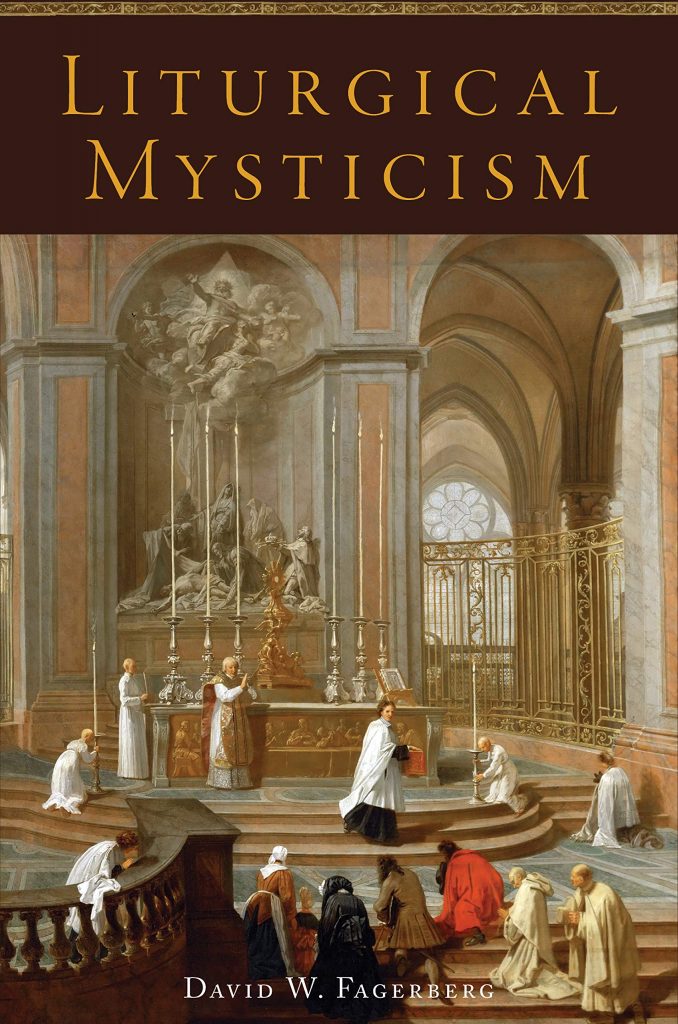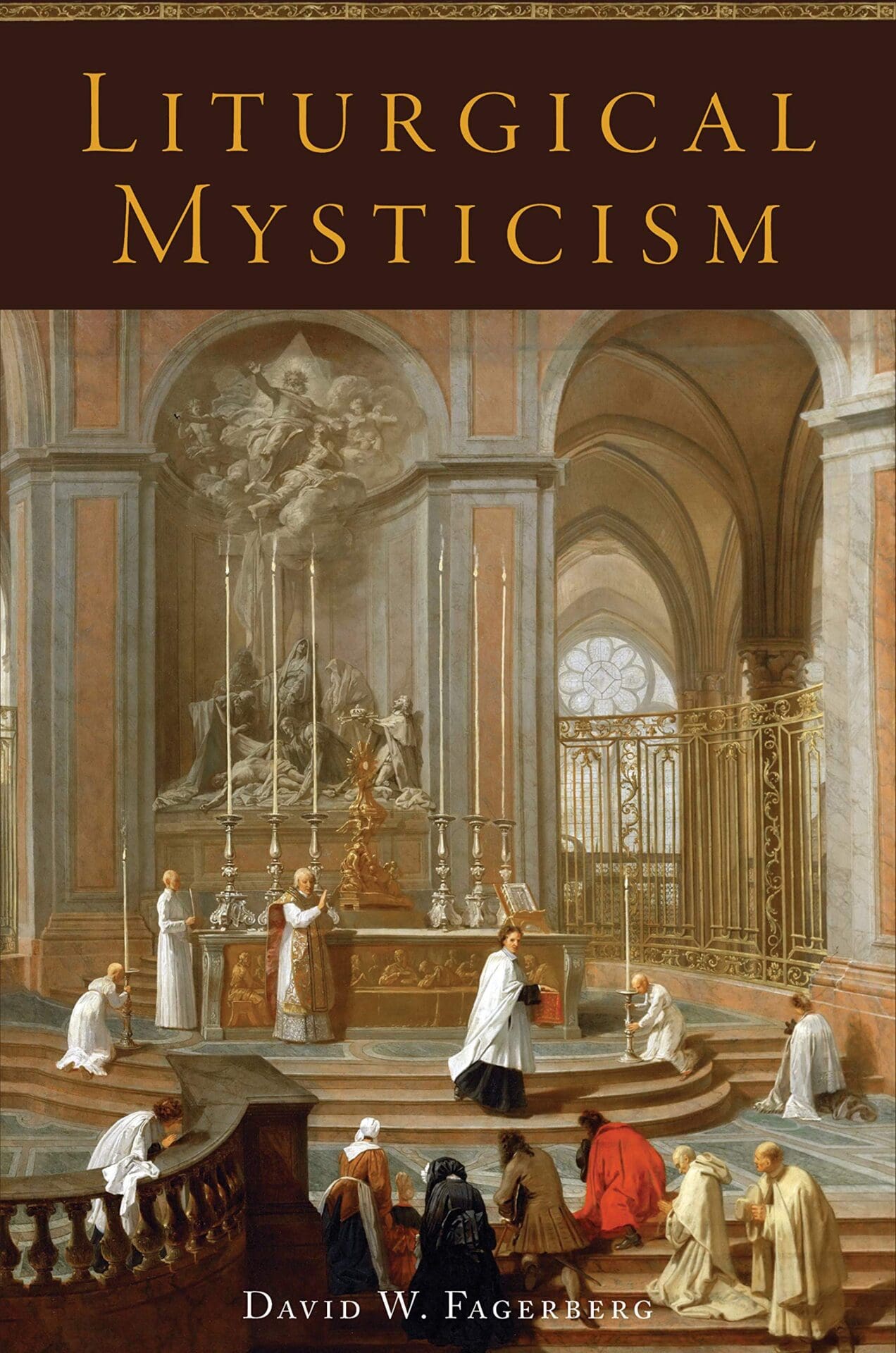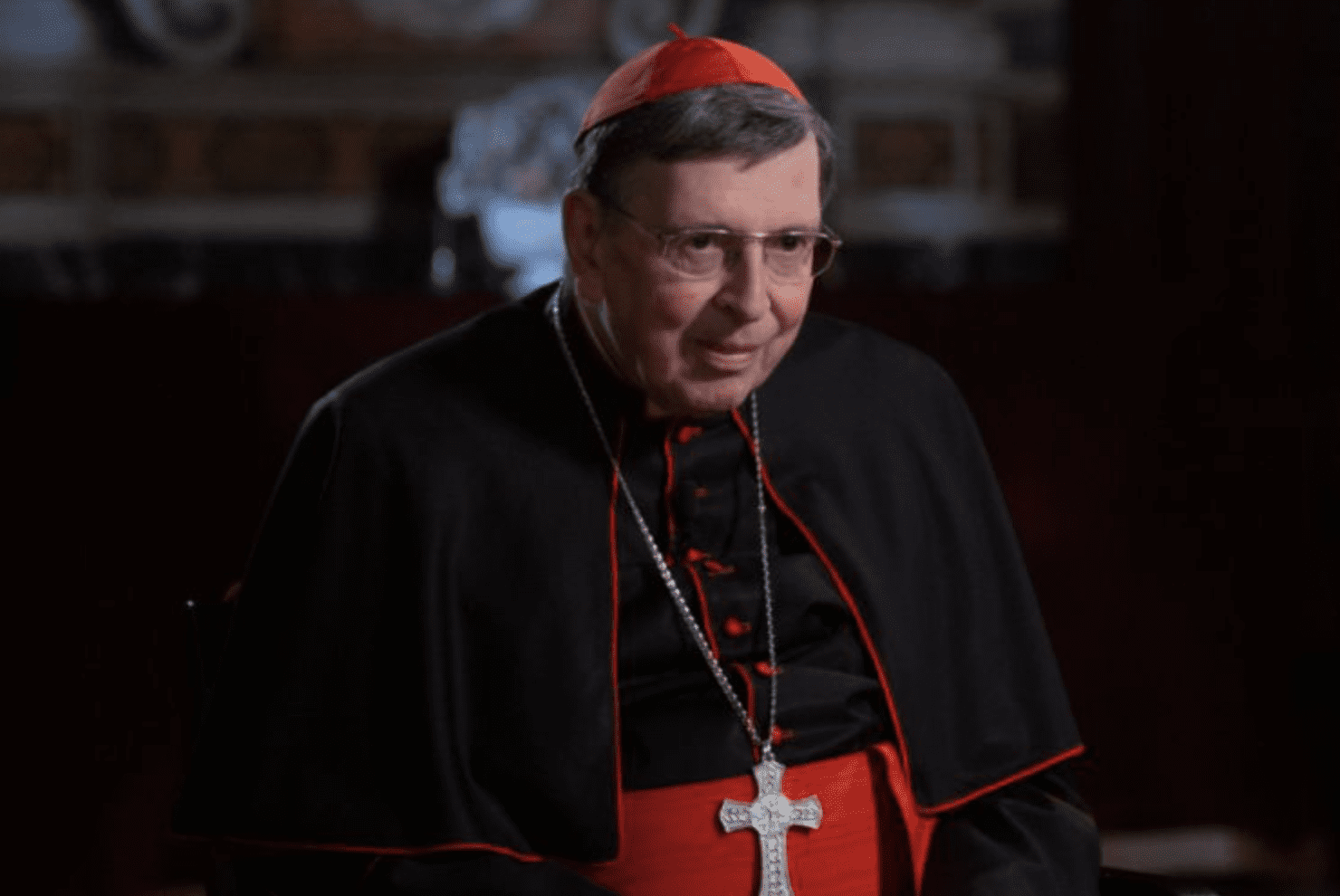Liturgical Mysticism by David W. Fagerberg. Steubenville: Emmaus Academic, 2019. 171 pp. ISBN: 978-1949013672. $29.95 Hardcover; $22.95 eBook.

In his encyclical on ecumenism, Ut Unum Sint, Pope John Paul II exhorts the faithful with this clarion call: the “Church must breathe with her two lungs!” (54). David Fagerberg demonstrates how to accomplish this task with his work Liturgical Mysticism. In his previous works, Fagerberg has drawn almost exclusively from the Eastern Christian authors; in Liturgical Mysticism, Fagerberg draws upon the wells of wisdom from the Church Fathers to more recent theologians of both the East and the West. Fagerberg masterfully weaves together the insights of the Church’s greatest thinkers.
Indeed, the names of the writers cited in the book offer an indication the breadth and depth of Fagerberg’s analysis: John Chrysostom, Gregory the Great, Gregory of Nyssa, John Climacus, Maximus the Confessor, Bernard of Clairvaux, Thomas Aquinas, Francis De Sales, Catherine of Siena, John Arintero, Jordan Aumann, Reginald Garrigou-Lagrange, Francis Libermann, Louis Bouyer, Matthias Scheeban, Columba Marmion, Paul Evdokimov, Pavel Florensky, Joseph Ratzinger, and Alexander Schmemann. This work should be read by both Catholics (from the Western and Eastern Churches) and our brethren in the Eastern Orthodox Church because of its engagement of both Eastern and Western Christian spirituality. Fagerberg’s work is an authentically ecumenical work, which models for the readers how to breathe with the Church’s two lungs
Trilogy Complete
Liturgical Mysticism is the culmination of Fagerberg’s triptych on the liturgy, which includes his two previously published works, Consecrating the World (Angelico Press, 2016) and On Liturgical Ascetism (CUA Press, 2013). The mystical life in Fagerberg’s estimation is “the normal crowning of the Christian life because eternal life is the life for which we yearn” (xvii), so it is fitting that this book rounds out his liturgical trilogy. The desert monk Evagrius exhorts us to remember that “the one who is a theologian, prays.” Fagerberg consistently reminds his readers that the one who is a liturgist, worships, and the one who is an ascetic, practices self-denial.
The life of a mystic is the end for all Christians who embrace their vocation as it is for the theologian, the liturgist, and the ascetic. Under the influence of his two mentors, Alexander Schmemann and Aidan Kavanagh, Fagerberg consistently argues that the liturgy is the ultimate source of theology—theologia prima. The contribution of his most recent work is to offer insight into the inherent relationship between liturgy and mysticism.
Fagerberg rejects the “either/or” dichotomy, which would separate the “Church and world, mystery and the mundane, eschaton and time, liturgy and life” (xviii) in the lives of the faithful. The sacraments and the sacred liturgy are sources of sanctification of every aspect of life. The liturgy enables us to have access to the Paschal Mystery, which in turn should transform our everyday lives with the graces of the mystical life: “Liturgical mysticism is the development of graces received in baptism; liturgical asceticism is the process which develops those graces; the product of those graces is a liturgical theologian who is enlightened. Liturgical mysticism wants to know what is done inside a person by the liturgy” (xviii-xix). The focus of this book is to examine what happens within a person as fruit of his participation in the liturgy (mysticism), while works of liturgical theology focus on what happens in the liturgy. In this brief work, Fagerberg unpacks one of his concise (and, as always, very dense) definitions: “Liturgical mysticism is the Trinitarian mystery, mediated by sacramental liturgy and hypostasized as personal liturgy, to anchor the substance of our lives” (xxi). In other words, mysticism is simply our participation in the life and love of the Persons of the Trinity via the signs and symbols of the liturgy. Both the academic liturgist and the everyday liturgist—say, Mrs. Murphy—could equally benefit by entering into this understanding with Fagerberg as their guide.
Mysticism is simply our participation in the life and love of the Persons of the Trinity via the signs and symbols of the liturgy.
The interpretive key to unlocking the meaning of liturgical mysticism is the Greek word hypostasis, which was adopted by the Fathers in the development of Christology. Citing the work of G.L. Prestige, Fagerberg notes that the ancient meaning of hypostasis was a reference to the “dregs of wine in a cask” (78). In other words, the hypostasis is the essence or substance of a thing. Applying this to the reality of the liturgy, Fagerberg argues, “Liturgy’s business is to celebrate the Paschal mystery, and when it does, the mystery hypostasizes in us, descends to us, takes up home in us, becomes the substance of our lives” (78). The mystery of the Incarnation becomes transformative for the person participating in the liturgy. In the words of the Fathers such as Athanasius, “God became man, so that man might become God.” The human person becomes by grace what Jesus Christ is by nature.
The Incarnation is the other side of the mystical deification that is realized through grace in the interior lives the faithful. According to Fagerberg, “Christ’s God-manhood is the prototype of the icon we are mystically becoming. When it mystically hypostasizes in our substance, then Christ’s Church, his mystery, will be beautiful in us” (78-79). Liturgical Mysticism is simply a Christocentric liturgical theology, which develops the full implications of the relationship between the lex orandi (liturgy), lex credendi (theology), and lex vivendi (ascetism).
God in All
The development of the hypostasis of Christ begins with the liturgy because it is formal. Building upon the insight of Paul Holmer, Fagerberg argues the liturgy is formal in the sense that God determines the form of liturgy as latria (adoration) and not simply dulia (veneration) in Chapter 1. God is the object and subject of the liturgy because it is latria. If the liturgy were dulia, then the worshipers would become the subjects of the liturgy and hence liturgy would change with the whims of the subjects. Liturgy as latria directs the person to become transformed by communion with the Logos.
Hence, St. Paul describes the formal grammar of the liturgy as logike latreia (Romans 12:1). The liturgy capacitates the person to form his life into a living sacrifice shaped by the Logos. With his stylistic clarity, Fagerberg notes: “Liturgy is heaven on earth, liturgists are mystics, and these liturgical mystics undergo the asceticism which is the cost of being made Christoform in order to commit liturgy. The parts of the Christian life—liturgy, theology, asceticism—interweave mystically with each other like dancers around the Maypole” (19). The life of mysticism is normative for every ordinary Christian, in Fagerberg’s view.
Mysticism is not simply for exceptional or extraordinary Christians. In Chapter 2, beginning with the insight of Reginald Garrigou-Lagrange, Fagerberg rejects the divorce between ascetism and mysticism. The artificial separation leads to an insurmountable divide between ordinary and extraordinary Christians. The liturgy gives every ordinary Christian access to the mystical life because liturgical mysticism is “liturgy mystically energizing an individual member of the mystical body that the leitourgia has created” (31). Baptism forms each individual into a liturgical person as it gives him a share in sanctifying or deifying grace (cf. Catechism of the Catholic Church, 1999). Mysticism is simply the consummation of the potential deification which begins with Baptism. The hypostasis of Christ is accessible via the celebration of the liturgy: “Liturgy is the perichoresis of the Trinity reaching out to us through the kenosis of the Son in order to invite our synergistic ascent to deification. That is the substance [hypostasis] that occurs in all our ritual liturgies” (39). Mysticism is aptly described as “liturgical” because the liturgy offers the faithful a way into to the mysteries of Christ’s life.
In light of the foundation laid by the first two chapters, the liturgical nature of theological anthropology is the theme of Chapter 3. According to Fagerberg, “Liturgical mysticism is personal insofar as it is the mystery of Trinitarian love being reproduced in a person’s soul, and the soul of a liturgical person receives personhood from the corporate, sacramental body acting as an instrument of Christ” (44). In contrast with the modern view of the person, which reduces the person to an individualistic autonomous subject, the liturgy hypostasizes a sacramental life within the person which is ordered towards communion and self-giving love for another. Mysticism is mediated to the faithful through the liturgy celebrated by the Church that leads us into the heart of the Paschal mystery. Hence, Fagerberg argues, “Being baptized by sacrament into his mystery makes our lives a personal liturgy rotating around the twin poles of glorifying God and cooperating with our sanctification” (49).
Way of the Cross
The latter half of Fagerberg’s work focuses on the ascent towards mysticism and the eschaton, which passes through the path of asceticism (Chapter 4) and the Cross (Chapter 5). Fagerberg maintains the view that “Asceticism and mysticism share a liturgical unity, and they will not let go of their embrace until the Parousia” (65-66). Chapter 4 offers an invaluable reflection upon eight logismoi that affect the passions and consequently the liturgical mystery: gluttony, impurity, avarice, sadness, anger, acedia, vainglory, and pride (67-74). The remedy to order the passions is the life of the Logos becoming our life by our participation in the liturgy. Consequently, Fagerberg underscores the “Paschal mystery hypostasizing in our hearts” (78) as a definition of liturgical mysticism. The sacramental liturgy and the personal liturgy are united in the ascetical life.
Consistent asceticism prepares the room of our hearts for the development of the hypostasis of Christ within us. The challenge of ascetism is death, which must take place on a daily basis as we move from the Cross to the Resurrection. Chapter 5, in contrast with the previous chapter, highlights the theological virtues of faith, hope, and charity as names for the subjective condition for belief in the Resurrection. Human belief alone is insufficient and the liturgy, which offers the gift of mystical communion with Christ, forges the habit of Christ’s faith, hope, and charity within us.
The final chapters of Liturgical Mysticism (Chapters 6 and 7) outline the mystical state which is the fruit of the liturgy and the intrinsic link between the liturgy and the eschaton. The liturgy offers a foretaste of the eschaton through the mystical life: “The mysticism is liturgical because we are following Christ in all things. The liturgy is mystical because our transfer form Hades to the heavenly Jerusalem can be pre-experienced, anticipated, celebrated, already undergone premortem” (118). Through the Incarnation, the eternal Logos became flesh and this mystery is extended via the celebration of the liturgy.
Christ’s death and resurrection has opened the gate towards deification through communion with and within the inner life and love of the Trinity. Mysticism is simply our ascent towards this union with God. Consequently, the Eucharist is the eschaton simultaneously anticipated and not yet fulfilled. Highlighting the notion of hunger and thirst, Fagerberg comments the Eucharist both “increases our hunger” and “amplifies our thirst”; the Eucharist neither satisfies our hunger nor satiates our thirst (138). Liturgical mysticism enables us to live fruitfully between the eschatological “already” and “not yet.” The eschaton is simply the liturgy reaching its full fruition: communion with God and the blessed company of the saints. Holy Communion is a foretaste of the heavenly communion.
Lived Liturgy
David Fagerberg’s Liturgical Mysticism should be prayerfully read by all the faithful because the liturgy has in practice become something that we passively attend or we objectively study. As with all works of Fagerberg, the liturgy is primarily understood by worshiping and by recognizing that the liturgy is the primary subject of theology. This work is a sober reminder that the liturgy mystically transforms the interior life. Prima facie, Fagerberg’s work is needlessly repetitive, but the repetition of definitions and phrases is analogous to the use of antiphons within a chant. The constant use of the refrains relating to theology, mysticism, liturgy, kenosis, perichoresis, the world, culture, and the Cross are essential to understanding the true Trinitarian and Christocentric spirit of the liturgy. The main takeaway from all of Fagerberg’s work is the Liturgy enables every Mrs. Murphy to become a mystic and a liturgist through her full participation in the liturgy. Theologians and liturgists could learn invaluable lessons from a faithful Mrs. Murphy.
A drawback of this work is that it can only be fully appreciated by reading the previous works of Fagerberg. Nevertheless, engaging the works of Fagerberg offers a renewed understanding of the liturgy that takes place within the interplay between theology, asceticism, and mysticism: “Liturgical asceticism kneads both body and soul with that resurrection power; liturgical mysticism looks fixedly at the mystery, who is Christ risen; and liturgical theology illuminates our world and our place in it” (149). Although one may need both a theological dictionary and simply Webster’s Dictionary, resilient readers will find that Fagerberg is able to “demystify” mysticism by explaining this concept in its proper liturgical context. The liturgical mystical life is only the beginning of the transformation of the human person through the grace of the Paschal Mystery, but it is the necessary path for all Christians towards full communion with God. God has become man and via the celebration of the liturgy, the believer is able to enter into the life of Jesus, which He shares with the Father and the Holy Spirit.


